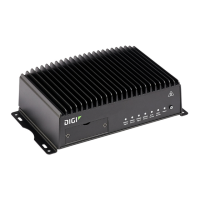Routing Dynamic DNS
Digi TransPort WR Routers User Guide
180
digi.router> show routing rule
# Oper Status WAN Description
--------------------------------------
1 Up 1 LAN 1 > WAN 1
2 Up 2 LAN 2 > WAN 2
digi.router>
Dynamic DNS
The Domain Name System (DNS) uses name servers to provide a mapping between computer-
readable IP addresses and human-readable hostnames. This allows users to access websites and
personal networks with easy-to-remember URLs. Unfortunately, IP addresses change frequently,
invalidating these mappings when they do. Dynamic DNS has become the standard method of
addressing this problem, allowing devices to update name servers with their new IP addresses.
By providing the TransPort devices with the hostname, service, and credentials obtained from a
dynamic DNS provider, the router can automatically update the remote nameserver whenever your
WAN or public IP address changes.
TransPort devices support the following Dynamic DNS providers:
n DynDNS https://dyn.com/
n No-IP https://www.noip.com/
n DNS-O-Matic https://www.dnsomatic.com/
n ChangeIP https://www.changeip.com/
Configure dynamic DNS
This section describes how to cofigure dynamic DNS on a TransPort device. For details on dynamic
DNS, see Dynamic DNS
Required configuration items
n Enable Dynamic DNS
n Service: Provide the name of a Dynamic DNS provider (for example, dyndns, dnsomatic, noip,
changeip).
n Username: Provide username to be used to authenticate with your Dynamic DNS provider.
n Password: Provide the password corresponding to the username provided above.
n Hostname: Provide the URL for your Dynamic DNS provider, which will be linked to your IP
address.
Additional configuration items
n ip-monitoring: Use this option to determine which IP address to monitor for changes. If you
select WAN, the TransPort monitors the IP address of WAN interfaces. If you select Public, the
TransPort monitors the public-facing IP address, regardless of the IP address of the WAN
interface.
Command line

